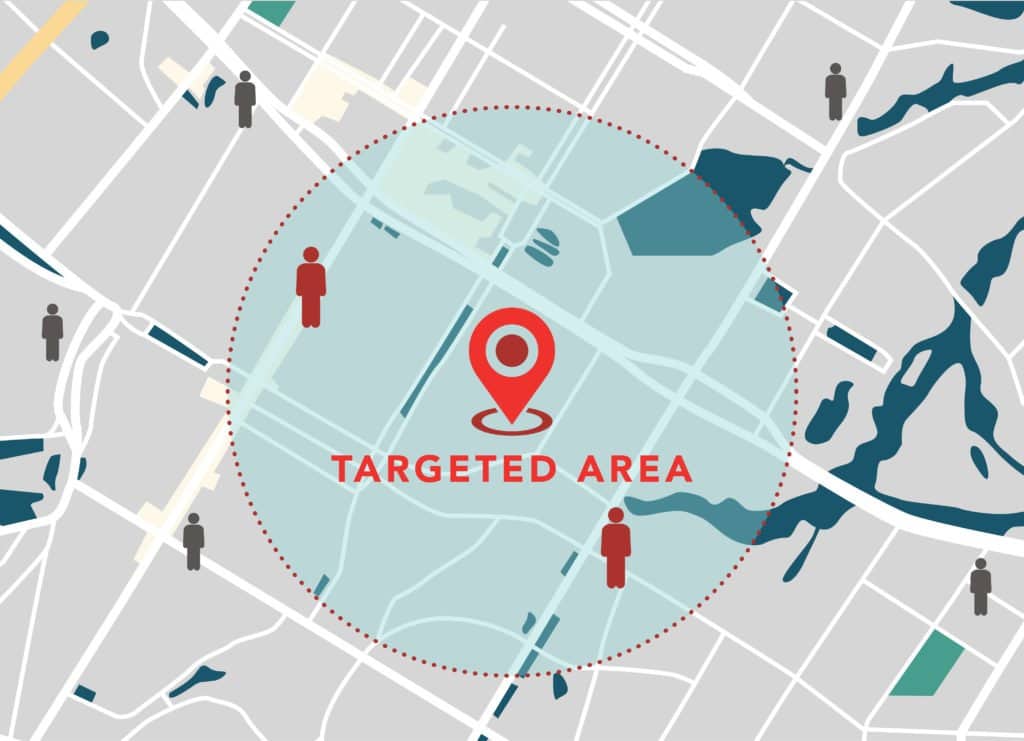What is Geofencing?
There are a lot of potential applications for geofencing technology, but for the purposes of this article, we’ll be focusing on how geofencing technology can be leveraged for marketing and advertising.
Geofencing is an advertising technology (ad tech) that allows you to serve ads to people who enter an imaginary boundary that you have created around a real-world physical location. For example, if you’re a real estate company promoting a new development, you might choose to target people who have visited a competing sales office. You can then target ads to devices that enter the digital “fence” you have created.
How Does Geofencing Work?
Geofencing uses a mix of GPS data, RFID, Wi-Fi, and cellular networks to track the location of users (most often, users of a mobile app) and trigger an action when they enter the boundaries that you have set.
These boundaries could encompass a single building, neighborhood, or a five-mile radius around individual restaurants in a franchise.
The ways in which geofencing is implemented can vary. In some cases, you might only be able to serve ads to individuals while they are in a given location. In others, you might be able to serve ads for a longer period of time (30 days, for example) after those individuals have left the geofenced location.
What Types of Goals Are Well-Suited to Geofencing?
Location-based Marketing
If you want to serve ads to individuals who attended a conference at a given location on a given date or if you want to serve push notifications to download a mobile app to enhance the experience in a physical location (like a brand app when customers enter your store or an app for an event), geofencing is a great fit for your goals.
Offline Attribution
Attribution is always a complicated problem to solve, even when the entire conversion path is online, but when you start needing to take offline actions into account when measuring the success of your campaigns, it becomes even more difficult.
For example, let’s say that I’m selling a product in a big box store. I’m only selling my product through third-parties, you can’t buy it directly from my website. And it’s really important to me that I push people in my target audience to that store so they can buy the product there.
It’s easy for me to measure who is clicking on my ads and whether they’re reaching a landing page with more information (including where they can buy), but I’m not able to connect the dots between how many of the people who see and click my ads are also visiting that big box store shortly after seeing my ad.
However, as you might have guessed, geofencing can be used for more than just targeting ads. It can also be used for offline attribution. With a geofencing campaign, I can more fully connect the dots between which target audiences are clicking on my ads but then taking no further action and which audiences are making it into the big box store after seeing my ad. This is valuable data that allows for a level of optimization that wasn’t available to me for this campaign without geofencing technology.
Generally speaking, if you want to reach an audience based on a physical location they are visiting or you have a goal that involves a real-world space, such as driving foot traffic into a brick and mortar store or restaurant, geofencing is a solution to consider.
An example of a successful geofencing campaign is American Eagle clothing store. They targeted people entering a geofenced mall parking lot and sent them push notifications with promotions. The result? A three-fold increase in sales because they attracted shoppers into their stores while at the mall.
When Does Geofencing Not Work?
When You Don’t Have A Physical Location Worth Geofencing
Geofencing isn’t an ideal solution if your customers are spread out over a large area (across a state, multiple cities, or an entire country) and you also have no physical location (such as brick and mortar store locations or competitor locations) that would be useful to geofence.
For example, let’s say that I’m a B2B software-as-a-service (SaaS) brand. My customers come from a wide variety of industries and are companies, both big and small. Most of them start their research online, read some content, complete a form, and then connect with a salesperson. For the vast majority of my customers, the entire buying process will happen online, without the customer ever entering my physical office space or a competitor’s space.
Geofencing isn’t useful in this scenario.
When You Don’t Have the Right Tools In Place
Even if your goals and strategy are a good match for geofencing, you’re still unlikely to see good results if you don’t have the right tools in place.
For example, if I were running a Google Display campaign I could target a large geographical area with my ads, but I couldn’t effectively serve ads to individuals who attended a conference in a specific building or individuals who had visited a competitor’s brick and mortar store.
If I just wanted to target everyone in a five- or ten-mile radius around a restaurant location, I could accomplish that with a Google Display campaign, but if I wanted to truly tap into the most advanced features that set geofencing apart from geo-targeting, I’d need to utilize an advertising platform that was built with true geofencing in mind. What’s the difference? Geo-targeting is the ability to target a device based on its geographic location. Think targeting by country, state, metro area, city, neighborhood, and zip code. However, geofencing is much more precise — being able to target a single block or building.
Will Geofencing Work For You?
If you have a compatible goal, a location that you can geofence, and a proper geofencing solution, then geofencing could be a solid option to test for your campaign.
A few questions that you should ask before diving into geofencing for your next campaign are:
- Do you have the right solution to manage and measure a geofencing campaign and make adjustments to maximize results?
- Does your geofencing solution deliver on your specific needs?
- For example, being able to serve an ad or push notification immediately versus being able to add individuals to a target audience for a longer-term campaign.
- Is there another tactic that you haven’t explored that might be more effective for your particular campaign?
- Geofencing is a powerful technology, but you should avoid falling into “shiny new object” syndrome and only leverage it when it’s the right fit for your goals.
- Select the tactic that best fits your strategic needs, even if your boss got really excited after reading this article about geofencing.
Geofencing can be an incredibly effective and powerful location-based marketing tool when executed correctly – the right message delivered to the right people in the right location with an appealing and measurable call-to-action. There are many companies that claim to specialize in geofencing, but before taking action, make sure you have clear goals and a well-defined strategy. FUEL can help develop, launch, and manage your campaign strategies. Contact us today to get started.







